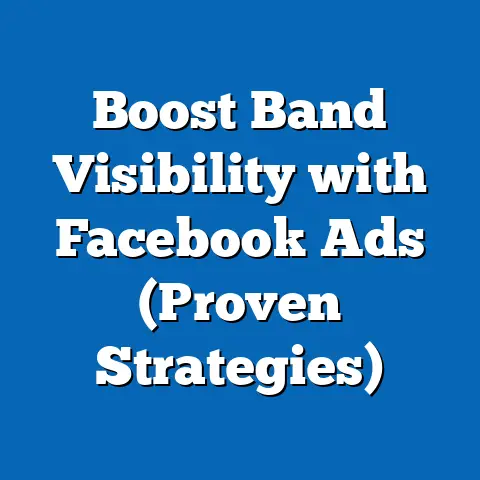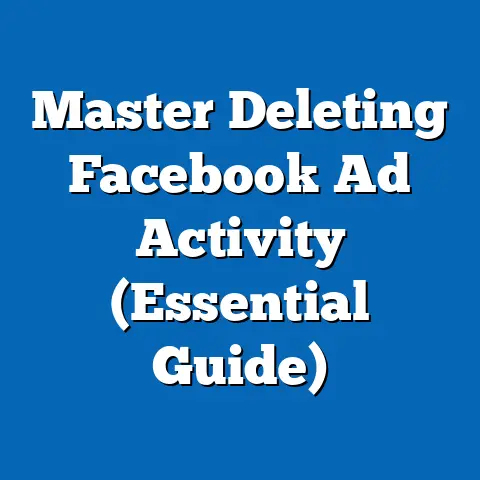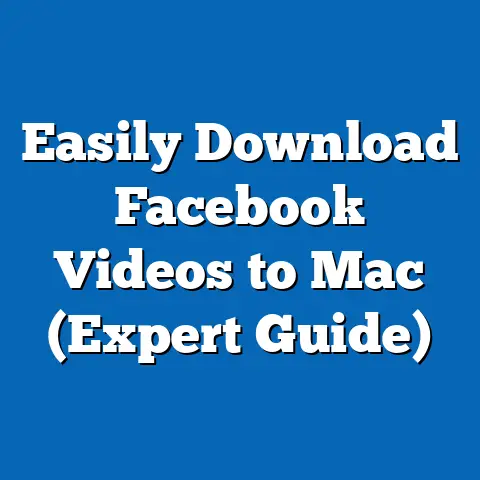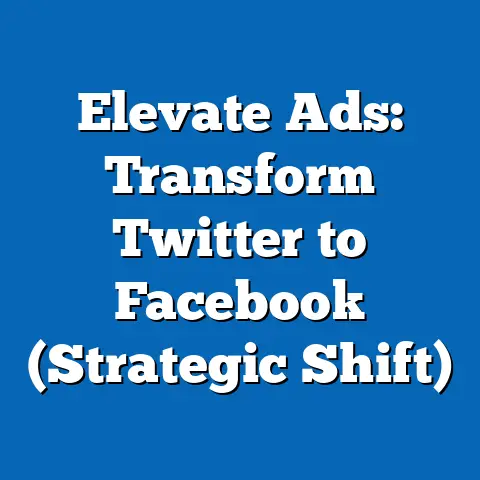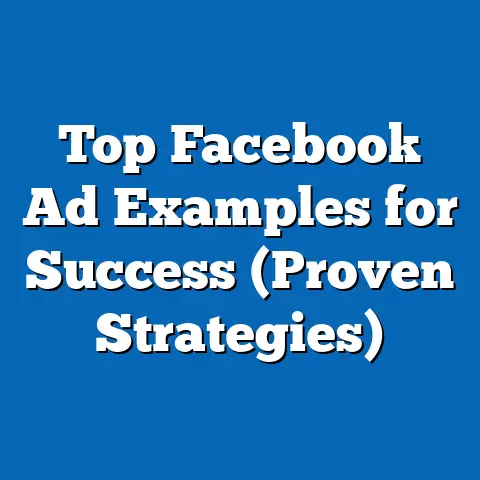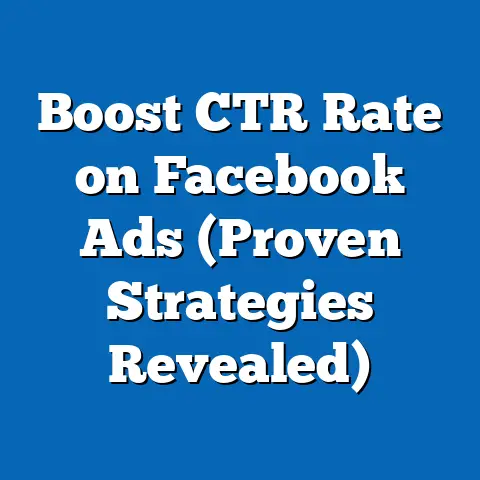Boost Facebook Ad Resolution (Expert Strategies Unveiled)
Isn’t it funny how a cat video can go viral in seconds, yet your meticulously crafted Facebook ad barely gets a glance? If only our ads had nine lives like our feline friends! I’ve spent years navigating the ever-changing landscape of Facebook advertising, and I’ve learned that while a catchy headline and a compelling offer are important, the visual appeal of your ad is often what makes or breaks its success. In today’s visually-saturated world, a blurry, low-resolution ad is like showing up to a black-tie event in your pajamas – it simply won’t cut it.
That’s why I’m diving deep into the world of Facebook ad resolution. I’m going to share expert strategies that I’ve personally used to transform lackluster ads into eye-catching masterpieces that grab attention and drive results. Whether you’re a seasoned marketer or just starting out, this guide will equip you with the knowledge and tools you need to make your Facebook ads shine.
Understanding Facebook Ad Resolution
So, what exactly do I mean by “ad resolution” in the context of Facebook advertising? It’s more than just the number of pixels in your image or video. It’s about the overall clarity, sharpness, and visual quality of your ad. It’s about ensuring that your ad looks crisp and professional, no matter where it’s being viewed – on a desktop, a tablet, or a smartphone.
Why High Resolution Matters
High-resolution ads are crucial for several reasons:
- Engagement: In a newsfeed flooded with content, a high-resolution ad immediately stands out. It grabs attention and encourages users to stop scrolling and take notice.
- Conversion Rates: A clear, visually appealing ad builds trust and credibility. When users can see the details of your product or service, they’re more likely to click through and make a purchase.
- Brand Perception: Your ads are a reflection of your brand. A low-resolution ad can make your brand look unprofessional and untrustworthy, while a high-resolution ad conveys quality and attention to detail.
- User Experience: No one wants to squint at a blurry image or struggle to read pixelated text. High-resolution ads provide a better user experience, which can lead to increased engagement and positive brand associations.
The Technical Side: Dimensions, Formats, and File Types
Now, let’s get down to the technical details. Facebook has specific recommendations for ad dimensions, formats, and file types. While these can change, here’s a general overview to get you started:
- Image Ads:
- Recommended Resolution: 1080 x 1080 pixels or higher.
- Aspect Ratio: 1:1 (square) for feed ads, 9:16 (vertical) for Stories.
- File Types: JPG or PNG.
- Video Ads:
- Recommended Resolution: 1080 x 1080 pixels or higher.
- Aspect Ratio: 1:1 (square) for feed ads, 9:16 (vertical) for Stories.
- File Types: MP4 or MOV.
- Carousel Ads:
- Recommended Resolution: 1080 x 1080 pixels or higher per card.
- Aspect Ratio: 1:1 (square).
- File Types: JPG or PNG.
- Collection Ads:
- Recommended Resolution: 1080 x 1080 pixels or higher for the cover image/video.
- Aspect Ratio: 1:1 (square) for the cover image, 9:16 (vertical) for the cover video.
- File Types: JPG, PNG, MP4, or MOV.
- Recommended Resolution: 1080 x 1080 pixels or higher.
- Aspect Ratio: 1:1 (square) for feed ads, 9:16 (vertical) for Stories.
- File Types: JPG or PNG.
- Recommended Resolution: 1080 x 1080 pixels or higher.
- Aspect Ratio: 1:1 (square) for feed ads, 9:16 (vertical) for Stories.
- File Types: MP4 or MOV.
- Recommended Resolution: 1080 x 1080 pixels or higher per card.
- Aspect Ratio: 1:1 (square).
- File Types: JPG or PNG.
- Recommended Resolution: 1080 x 1080 pixels or higher for the cover image/video.
- Aspect Ratio: 1:1 (square) for the cover image, 9:16 (vertical) for the cover video.
- File Types: JPG, PNG, MP4, or MOV.
Important Note: Always check Facebook’s official ad specs before launching your campaigns, as these requirements can change. You can usually find the most up-to-date information in the Facebook Ads Manager Help Center. I always do this before uploading any new creative, just to be safe!
How Resolution Impacts User Experience
Think about it from the user’s perspective. They’re scrolling through their feed, bombarded with information. A blurry, pixelated ad is instantly jarring and unappealing. It signals a lack of professionalism and can even make your brand seem less trustworthy.
On the other hand, a crisp, high-resolution ad is visually appealing and engaging. It draws the eye and invites the user to learn more. It conveys quality and attention to detail, which can significantly impact their perception of your brand.
Takeaway: High ad resolution is not just a technical detail; it’s a crucial element of user experience and brand perception.
The Psychology of Eye-Catching Ads
Beyond the technical specifications, there’s a deeper psychological element at play when it comes to creating eye-catching ads. High resolution is just the foundation; you need to understand how visuals influence emotions and behavior to truly connect with your audience.
Color Theory: More Than Just Pretty Hues
Color is a powerful tool in advertising. Different colors evoke different emotions and associations. For example:
- Blue: Often associated with trust, security, and calmness. It’s a popular choice for financial institutions and healthcare providers.
- Green: Represents nature, growth, and health. It’s often used by eco-friendly brands and organic food companies.
- Red: Evokes excitement, passion, and urgency. It’s often used for sales and promotions.
- Yellow: Associated with happiness, optimism, and energy. It’s often used to attract attention.
When choosing colors for your ads, consider your target audience and the message you want to convey. I once worked with a client in the travel industry who was struggling to attract bookings. We revamped their ads, using a vibrant blue to evoke the feeling of clear skies and calm waters. We saw a significant increase in click-through rates and bookings!
Visuals as Storytellers: Engaging Emotions
Humans are wired for storytelling. A compelling visual can tell a story in a way that words simply can’t. Think about the iconic Apple silhouette ads – they’re simple, elegant, and instantly recognizable. They tell a story about innovation, creativity, and design.
When creating visuals for your ads, think about the story you want to tell. What emotions do you want to evoke? How can you connect with your audience on a personal level?
Examples of Successful High-Resolution Ads
Let’s look at some examples of high-resolution ads that effectively leverage these psychological principles:
- Nike: Their ads often feature high-resolution images of athletes in action, conveying strength, determination, and achievement. They use bold colors and dynamic compositions to create a sense of excitement and energy.
- Airbnb: Their ads showcase high-resolution photos of unique and inviting properties, evoking feelings of wanderlust and adventure. They use warm, inviting colors and authentic imagery to create a sense of connection and belonging.
- Dove: Their ads feature high-resolution images of real women, celebrating diversity and body positivity. They use soft, natural colors and authentic imagery to create a sense of trust and authenticity.
Takeaway: Understanding the psychology of color and visual storytelling can help you create high-resolution ads that resonate with your audience on a deeper level.
Expert Strategy 1 – Leveraging A/B Testing
A/B testing, also known as split testing, is a fundamental strategy for optimizing any aspect of your Facebook ad campaigns, and resolution is no exception. It involves creating two or more versions of your ad (with slight variations) and showing them to different segments of your audience to see which performs better.
Setting Up A/B Tests for Ad Resolution
Here’s how I typically set up A/B tests to determine the optimal resolution for my Facebook ads:
- Create Two Versions: I start by creating two versions of the same ad, keeping all elements identical except for the resolution. For example, one ad might use a 1080 x 1080 pixel image, while the other uses a 1920 x 1080 pixel image.
- Use Facebook’s A/B Testing Tool: Facebook offers a built-in A/B testing tool within the Ads Manager. I use this tool to create a split test campaign.
- Define Your Budget and Timeline: I allocate a specific budget for the A/B test and set a timeline (usually 3-7 days) to gather enough data to make a meaningful decision.
- Target the Same Audience: It’s crucial to target the same audience with both versions of the ad to ensure a fair comparison.
- Monitor the Results: I closely monitor the performance of both ads, paying attention to metrics like click-through rate (CTR), engagement, and conversion rate.
Interpreting Test Results and Making Data-Driven Decisions
After the A/B test is complete, it’s time to analyze the results. Here’s what I look for:
- Statistical Significance: I use a statistical significance calculator to determine if the difference in performance between the two ads is statistically significant. This ensures that the results are not due to random chance.
- Key Metrics: I compare the CTR, engagement, and conversion rate of both ads. The ad with the higher performance in these metrics is the winner.
- Qualitative Feedback: I also pay attention to any comments or feedback from users. This can provide valuable insights into why one ad performed better than the other.
Based on the results, I make a data-driven decision about which resolution to use for my future ad campaigns.
Case Studies: A/B Testing Success Stories
I’ve seen firsthand how A/B testing can dramatically improve ad performance. Here are a couple of examples:
- E-commerce Store: An e-commerce store selling handmade jewelry increased their CTR by 25% by A/B testing different resolutions for their product images. They found that higher resolution images showcased the intricate details of their jewelry, leading to increased engagement and sales.
- Local Restaurant: A local restaurant increased their online reservations by 15% by A/B testing different resolutions for their food photos. They found that crisp, high-resolution images of their dishes made them look more appetizing, leading to more online orders.
Takeaway: A/B testing is an essential tool for optimizing your Facebook ad resolution. It allows you to make data-driven decisions and continually improve your ad performance.
Expert Strategy 2 – Utilizing Custom Audiences
Targeting is the cornerstone of effective Facebook advertising. You can have the most visually stunning ad in the world, but if it’s not shown to the right people, it won’t generate results. Custom audiences allow you to target specific groups of people based on their behavior, demographics, and interests.
Creating Custom Audiences
Here are some of the ways I create custom audiences for my Facebook ad campaigns:
- Website Traffic: I use the Facebook Pixel to track visitors to my website and create a custom audience of people who have visited specific pages or taken certain actions.
- Customer List: I upload a list of my existing customers (email addresses or phone numbers) to create a custom audience of people who have already purchased from me.
- Engagement: I create a custom audience of people who have engaged with my Facebook page or Instagram profile (e.g., liked a post, watched a video, or commented on an ad).
- Lookalike Audiences: I create a lookalike audience based on one of my existing custom audiences. Facebook will find people who share similar characteristics and behaviors.
Tailoring High-Resolution Ads to Specific Audiences
Once I’ve created my custom audiences, I can tailor my high-resolution ads to resonate with those specific groups of people. For example:
- Website Traffic: I might show a high-resolution ad featuring a product that a website visitor viewed but didn’t purchase. This is a great way to re-engage potential customers and encourage them to complete their purchase.
- Customer List: I might show a high-resolution ad featuring a new product or service to my existing customers. This is a great way to increase customer loyalty and drive repeat sales.
- Engagement: I might show a high-resolution ad featuring a special offer to people who have engaged with my Facebook page. This is a great way to reward loyal fans and encourage them to take action.
Examples of Successful Targeted High-Resolution Ads
Here are a couple of examples of businesses that have successfully used targeted high-resolution ads to boost conversions:
- Subscription Box Company: A subscription box company increased their sign-ups by 30% by showing high-resolution ads featuring the contents of their latest box to a custom audience of people who had visited their website but hadn’t subscribed.
- Online Course Provider: An online course provider increased their course enrollments by 20% by showing high-resolution ads featuring testimonials from satisfied students to a custom audience of people who had engaged with their Facebook page.
Takeaway: Custom audiences allow you to target specific groups of people with highly relevant high-resolution ads, leading to increased engagement and conversions.
Expert Strategy 3 – Crafting Compelling Visuals
Creating compelling visuals is an art form, but it’s also a skill that can be learned and honed. Here are some tips for creating high-resolution visuals that capture attention and drive results:
Tips for Creating Eye-Catching Visuals
- Use High-Quality Images: This may seem obvious, but it’s worth repeating. Use high-resolution images that are sharp, clear, and well-lit. Avoid blurry or pixelated images.
- Choose Relevant Images: The images you use should be relevant to your product or service and to your target audience.
- Use Eye-Catching Colors: Use colors that are visually appealing and that align with your brand.
- Use Compelling Text: Use text that is clear, concise, and easy to read. Avoid using too much text in your images.
- Use a Strong Call to Action: Tell people what you want them to do (e.g., “Shop Now,” “Learn More,” “Sign Up”).
Brand Consistency: Maintaining a Unified Look
Maintaining brand consistency is crucial for building brand recognition and trust. Use the same colors, fonts, and imagery across all of your ads and marketing materials.
I once worked with a client who had a beautiful logo and website, but their Facebook ads looked completely different. They were using different colors, fonts, and imagery, which created a disjointed and confusing brand experience. We revamped their ads to align with their brand, and we saw a significant increase in brand recognition and engagement.
Tools and Resources for Designing Ads
There are many tools and resources available for designing eye-catching ads. Here are a few of my favorites:
- Canva: A user-friendly graphic design tool that offers a wide range of templates and design elements.
- Adobe Spark: A powerful graphic design tool that allows you to create professional-looking ads.
- Unsplash: A website that offers a vast library of free, high-resolution images.
- Pexels: Another website that offers a wide range of free, high-resolution images and videos.
Visual Examples of Well-Crafted Ads
Let’s look at some examples of well-crafted ads that illustrate these principles:
- Warby Parker: Their ads feature high-resolution images of people wearing their glasses, showcasing their style and quality. They use clean, minimalist designs and clear, concise text.
- Headspace: Their ads feature calming, colorful illustrations that promote mindfulness and relaxation. They use simple, soothing designs and clear, concise text.
- Mailchimp: Their ads feature quirky, playful illustrations that promote their email marketing platform. They use bold, vibrant colors and humorous designs.
Takeaway: Crafting compelling visuals is essential for capturing attention and driving results. Use high-quality images, choose relevant colors, and maintain brand consistency.
Expert Strategy 4 – Optimizing for Mobile Devices
In today’s mobile-first world, it’s more important than ever to optimize your Facebook ads for mobile devices. The majority of Facebook users access the platform on their smartphones, so your ads need to look great on smaller screens.
The Growing Importance of Mobile Users
According to recent statistics, over 98% of Facebook users access the platform on mobile devices. This means that if your ads are not optimized for mobile, you’re missing out on a huge opportunity to reach your target audience.
Best Practices for Mobile-Friendly Ads
Here are some best practices for ensuring that your high-resolution ads are mobile-friendly:
- Use Vertical Video: Vertical video is the ideal format for mobile devices. It takes up the entire screen and provides a more immersive viewing experience.
- Keep It Short and Sweet: Mobile users have shorter attention spans, so keep your videos short and to the point.
- Use Clear and Concise Text: Use text that is easy to read on smaller screens.
- Use a Strong Call to Action: Tell people what you want them to do (e.g., “Swipe Up,” “Learn More,” “Download Now”).
Optimizing Ad Formats for Different Devices
Facebook offers a variety of ad formats that are optimized for different devices. Here are a few of the most popular:
- Single Image Ads: These ads feature a single image and are ideal for showcasing products or services.
- Video Ads: These ads feature a video and are ideal for telling stories or demonstrating products.
- Carousel Ads: These ads feature multiple images or videos that users can swipe through.
- Collection Ads: These ads feature a collection of products that users can browse.
Successful Campaigns Prioritizing Mobile Optimization
Here are a couple of examples of successful campaigns that prioritized mobile optimization:
- Fashion Retailer: A fashion retailer increased their mobile sales by 40% by using vertical video ads that showcased their latest clothing collections.
- Mobile Gaming Company: A mobile gaming company increased their app downloads by 30% by using short, engaging video ads that demonstrated the gameplay.
Takeaway: Optimizing your Facebook ads for mobile devices is essential for reaching your target audience and driving results. Use vertical video, keep it short and sweet, and use a strong call to action.
Expert Strategy 5 – Analyzing Insights and Metrics
Monitoring ad performance metrics is crucial for understanding what’s working and what’s not. By analyzing your metrics, you can identify areas for improvement and continually optimize your campaigns.
Key Metrics to Focus On
Here are some of the key metrics I focus on when analyzing the performance of my high-resolution ads:
- Click-Through Rate (CTR): The percentage of people who see your ad and click on it. A high CTR indicates that your ad is engaging and relevant.
- Engagement: The number of likes, comments, and shares your ad receives. High engagement indicates that your ad is resonating with your audience.
- Conversion Rate: The percentage of people who click on your ad and complete a desired action (e.g., make a purchase, sign up for a newsletter, or download an app). A high conversion rate indicates that your ad is effective at driving results.
- Cost Per Click (CPC): The amount you pay each time someone clicks on your ad. A low CPC indicates that your ad is efficient.
- Return on Ad Spend (ROAS): The amount of revenue you generate for every dollar you spend on advertising. A high ROAS indicates that your ad is profitable.
Adjusting Strategies Based on Analytical Insights
Based on my analysis of these metrics, I adjust my strategies to continually boost ad resolution and improve performance. For example:
- If my CTR is low: I might try different images or text to make my ad more engaging.
- If my engagement is low: I might try targeting a different audience or using different ad formats.
- If my conversion rate is low: I might try optimizing my landing page or offering a special discount.
Real-World Examples of Data-Driven Adaptations
Here are a couple of real-world examples of companies that have adapted their strategies based on data-driven insights:
- Online Retailer: An online retailer increased their ROAS by 20% by analyzing their ad performance metrics and identifying the most profitable ad formats and targeting options.
- Software Company: A software company increased their lead generation by 15% by analyzing their ad performance metrics and identifying the most effective call to action.
Takeaway: Analyzing your ad performance metrics is crucial for understanding what’s working and what’s not. Use your insights to adjust your strategies and continually improve your ad performance.
Conclusion: The Path Forward
I’ve covered a lot of ground in this guide, but the key takeaway is this: high-resolution ads are essential for success on Facebook. By implementing these expert strategies, you can create eye-catching ads that grab attention, engage your audience, and drive results.
Remember to embrace creativity and data-driven decisions in your Facebook ad campaigns. Don’t be afraid to experiment with different resolutions, colors, and formats. And always monitor your metrics to see what’s working and what’s not.
Even the most quirky ideas can lead to remarkable results in the digital marketing landscape. So, go out there and create some amazing high-resolution ads that make your brand shine! And who knows, maybe one of your ads will even go viral – just like those cat videos we all love!

